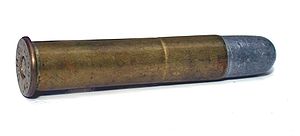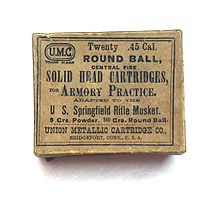.45-70 Government
| .45-70 Government | |
|---|---|

|
|
| general information | |
| Sleeve shape | Rim cartridge |
| Dimensions | |
| Sleeve neck ⌀ | 12.15 mm |
| Floor ⌀ | 11.6 mm |
| Cartridge bottom ⌀ | 15.4 mm |
| Sleeve length | 53.5 mm |
| Cartridge length | 69.4 mm |
| Weights | |
| Bullet weight | 26.2 g (405 grain ) |
| Powder weight | 4.5 g (70 grain ) |
| Technical specifications | |
| Speed v 0 | 402 m / s |
| Bullet energy E 0 | 2130-4000 J. |
| Lists on the subject | |
The .45-70 Government centerfire -Gewehrpatrone, as .45-70-405 called, was the beginning of the 1870s simultaneously with the Springfield Model 1873 -Gewehr as Ordonnanzpatrone developed for the US Army.
history
The predecessor of the .45-70 was the short-lived .50-70-425 cartridge introduced in 1866 and used primarily in rear-loading muzzleloading rifles, the Springfield Allin Conversion Model 1866 and Model 1868 Rifle and the Springfield Model 1870 Carbine . Since these weapons were not ballistically satisfactory, the development of a weapon and the associated ammunition in a smaller caliber with a higher muzzle velocity was required in order to achieve a more elongated trajectory. The weapon was developed and manufactured in the Springfield Armory, Massachusetts . The Frankford Arsenal near Philadelphia in Pennsylvania was entrusted with the development and production of the ammunition, which began producing them in series from 1874. This .45-70 center fire cartridge with a black powder charge of 70 grains became the orderly cartridge for the US Springfield Rifle Musket Model 1873 and its variants. For the Springfield Model 73 carbine and the cadet rifle, the powder load was reduced to 55 grains (3.6 g), otherwise these lighter weapons would have been difficult to control.
The .45-70 remained the orderly rifle cartridge of the US Army, Navy and Marines until it was superseded in 1894 with the introduction of the Krag rifle in .30-40 Krag . It is therefore also called .45-70 Government. It remained in service for secondary troops until the 20th century; it was also handed over to the US Department of the Interior for the Indian Police , which was armed with Remington Keene repeater , and was later joined by the National Guard and militias of individual states.
technology
| parameter | inch | mm |
|---|---|---|
| Bullet diameter | .458 | 11.6 |
| Sleeve length | 2,105 | 53.5 |
| Cases in front of the cartridge base | .501 | 12.72 |
| Sleeve neck | .480 | 12.2 |
| Cartridge length | 2,550 | 64.8 |
| Cartridge bottom diameter | .608 | 15.4 |
The full designation of the cartridge was .45-70-405: .45 (11.4 mm) for the caliber, 70 grains black powder charge and 405 grains (26.2 g) bullet weight. The sleeves are slightly conical.
The sleeves produced until 1887 consisted of a copper alloy called "Bloomfield's Gilding Metal". Until 1882, like the .45 Colt revolver cartridges, they had internal Benet fuses. These early cartridges can be recognized by the flat case base and the lateral indentations on the back of the case to fix the detonator inserted from above. The front round soft lead bullet weighed 405 grains and was .458 inches (11.6 mm) in caliber.
From 1882 onwards, boxer ignition was used, which allowed the ammunition to be reloaded in the field. At the same time, instead of the round head bullet weighing 405 grains (26.2 g), a heavier bullet of 500 grains was introduced for the infantry rifles, which should bring better results in long range volleys at group targets.
From 1888 the sleeves were made of brass, until 1900 they were tin-plated, from 1900 until the end of production they were bare.
variants
- Blank cartridges
- Multiball cartridges with two round balls
- Shotgun shells, with these the shot was loaded in a hollow wooden ball
- Armory Practice cartridge with 5 grains powder charge and a round ball of 140 grains
Manufacturer
In addition to the Frankford Arsenal, the ammunition was supplied to the US Army by the following third-party suppliers:
- Winchester Repeating Arms , New Haven, CT
- Union Metallic Cartridge Company , Bridgeport, CT
- United States Cartridge Company , Lowell, MA
Civil use
Like all US Army cartridges, the .45-70 was also used in the civilian sector. Various companies such as Remington, Sharps and Winchester with the lever action rifle Model 1886 manufactured single-shot and repeater for this cartridge. As a hunting ammunition, it is suitable for shooting all game occurring in North America, but because of the arcuate trajectory it was limited to a practical shooting distance of 120 m.
Even today, the cartridge is offered with various charges and bullet weights from 300 to 500 grains and various companies such as Ruger , Thompson Center Arms , Marlin Firearms manufacture hunting rifles in .45-70 caliber.
Today gunpowder shooters load it themselves in various loads and also use it as a blank cartridge for historical occasions.
The US company Magnum Research Inc. in Fridley, MN even has a five-shot, 2.4 kg revolver on offer that, like the single-shot Contender single -shot pistol manufactured by Thompson Center Arms , fires modern .45-70 cartridges with a Projectile energy of 2700 J are about twice as strong as a .44 Magnum cartridge.
literature
- Joe Poyer, Craig Riesch: The .45-70 Springfield . North Cape Publications, Tustin, CA 1996, ISBN 1-882391-25-X .
- John E. Parsons, John S. du Mont: Firearms in the Custer Battle . The Stackpole Company, Harrisburg, PA 1953, LCCN 53-010563 .
- Norm Flayderman: Flayderman's Guide to Antique Firearms . Krause Publications, Iola, WI 2001, ISBN 0-87349-313-3 .


